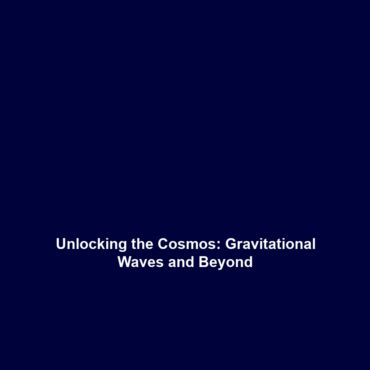Cosmic Events Beyond the Observable Universe: How Gravitational Waves Expand Our Observational Reach
Introduction
The study of gravitational waves has revolutionized our understanding of the universe, particularly concerning cosmic events beyond the observable universe. These ripples in space-time, first predicted by Einstein, now provide a powerful tool for astrophysicists to probe phenomena that elude traditional telescopic observation. By detecting these waves, scientists can uncover hidden details about events such as black hole mergers and neutron star collisions, broadening our knowledge of the universe’s structure and evolution.
Key Concepts
Understanding Gravitational Waves
Gravitational waves are disturbances in the curvature of space-time generated by accelerated masses, such as colliding black holes or neutron stars. They carry information about their origins and about the nature of gravity itself.
Cosmic Events Beyond the Observable Universe
These cosmic events refer to phenomena occurring at distances or under conditions that cannot be directly observed. Gravitational waves offer insights into these events, allowing astronomers to hear what lies beyond the observable range. This is significant because it changes our perception of the universe’s boundary, enabling us to map its structure more comprehensively.
Applications and Real-World Uses
The implications of exploring cosmic events through gravitational waves extend into various fields:
- Astrophysics Research: Gravitational waves provide data that refine theories about the universe’s expansion and structure.
- Cosmology: They help in understanding the origins of cosmic structures including galaxies.
- Technology Development: Techniques developed for gravitational wave detection enhance other scientific instruments.
In summary, the application of gravitational waves in exploring cosmic events allows scientists to expand their observational catalog significantly.
Current Challenges
Despite their exciting potential, several challenges exist in the study of cosmic events beyond the observable universe:
- Detection Sensitivity: Current detectors like LIGO and Virgo are limited in sensitivity and can only observe a fraction of gravitational wave events.
- Data Interpretation: The interpretation of wave signals can be complex and subject to noise interference.
- Funding and Resources: Continued advancements require significant funding and international collaboration.
These factors highlight the challenges of studying gravitational waves in the cosmos.
Future Research and Innovations
Looking ahead, several promising advancements are set to enhance the study of gravitational waves and their relation to cosmic events:
- Next-Generation Detectors: Projects such as the Einstein Telescope and LISA aim to increase sensitivity to gravitational waves.
- Multi-Messenger Astronomy: Combining gravitational wave data with electromagnetic signals could yield richer cosmic insights.
- Artificial Intelligence: AI tools are being developed to improve the detection and analysis of gravitational wave events.
These innovations could radically transform our understanding of gravitational waves and their cosmic implications.
Conclusion
In conclusion, the exploration of cosmic events beyond the observable universe through gravitational waves represents a frontier in modern astrophysics. This field holds the potential to provide answers to fundamental questions about the nature of the universe. As advancements continue in detecting and interpreting these waves, we encourage further reading on related topics such as gravitational wave research and cosmology and gravity. Together, we can unravel the mysteries that lie beyond our current observational limits.
